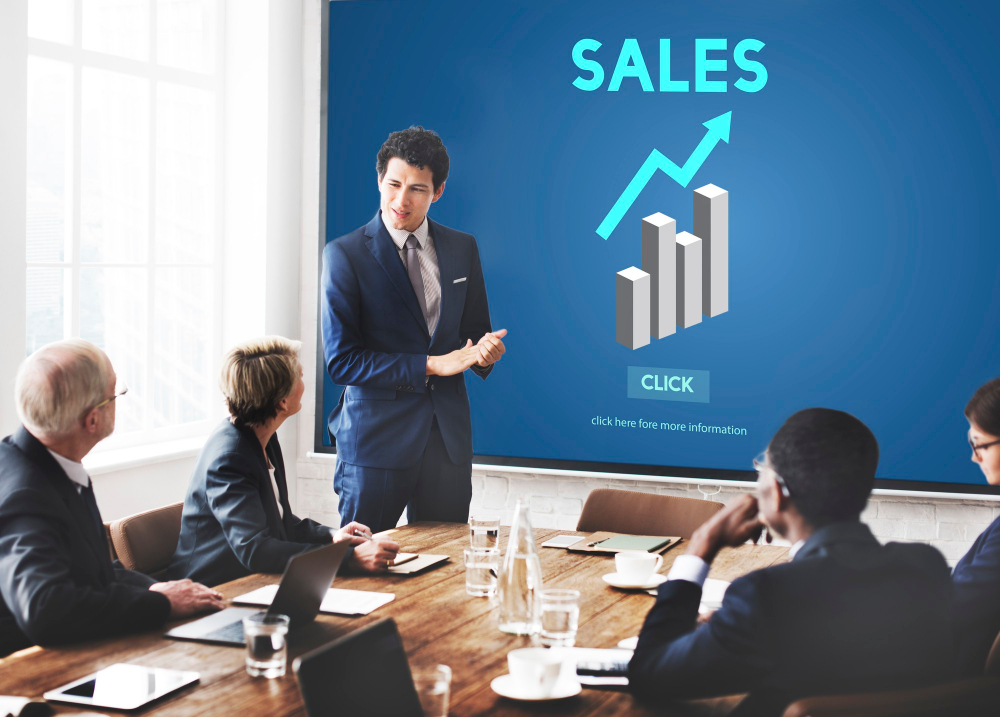MARKETING
Key Points You Need to Know About Sales Enablement

Some companies believe that sales reps need nothing besides proper sales tactics and sales skills to effectively sell products or services.
The truth is that sales reps need way more in order to achieve great results – training materials, tools, and resources. Sales enablement is exactly what they actually need to walk leads through the buyer’s journey successfully.
Yet, what is sales enablement, exactly? What about the sales enablement strategy? Why should you implement it into your selling strategy and how can sales enablement impact your business and revenue positively? We’ve answered all of these questions below!
What Is Sales Enablement?
Sales enablement makes it a breeze for salespeople (the ones that are remote selling in the first place) to connect with prospects and help them close more deals. It equips them with the right knowledge, content, and information and engages and empowers them to hit their quota.
In other words, sales enablement is the key to selling more effectively and, more importantly, the key to your company’s growth.
It is also kind of a mindset thing. Shifting the existing beliefs and patterns of thinking can help your sales representatives start believing that they can develop basic abilities and become more successful at selling and establishing long-term relationships with customers.
Now that we’ve mentioned customers, keep in mind that sales enablement doesn’t only benefit sales reps and your company but your customers as well since it ensures better customer experiences, too!
Thus, salespeople should get plenty of resources and information to learn from that will help them be better at what they do. Yet, all this can be in vain if the appropriate training on how to use these resources and how to improve sales skills is provided.
Finally, once a sales rep has gotten all the possible support on how to engage, attract, and satisfy the customer, the company should track how they are using this knowledge. Keep an eye on the metrics and results for sales representatives – what’s their average deal size, are they achieving their quota, etc.
6 Benefits of Sales Enablement
There is a plethora of benefits sales engagement provides and these are the main ones:
- It provides a strict and easy-to-follow framework to all salespeople in your company so that even the lowest-performing people can start delivering significantly better results,
- It increases predictability and helps with optimizing your sales funnel, which, ultimately, results in closing more deals and establishing stronger customer relationships,
- It enables collecting more valuable data salespeople can use to convince prospects to make a purchase without coming across as pushy,
- It boosts the quality of sales conversions,
- It aligns marketing and sales teams on the tactics and goals since both marketing and sales own sales enablement and impact the sales enablement strategy.
What Is a Sales Enablement Strategy?

A sales enablement strategy is a pretty much self-explanatory thing. It’s basically a strategy you plan to implement to help salespeople in your organization sell more effectively and efficiently.
There is no such thing as one-size-fits-all and you need to tailor the strategy to the needs of your sales team and customers. We’ve already mentioned some of the elements of a sales enablement strategy throughout the text but here’s the complete list:
- Resources and materials or, in short, content (blogs, case studies, podcasts, webinars),
- Sales coaching and sales performance coaching (it teaches salespeople how to use the resources provided),
- Sales enablement and analysis/reporting tools and software.
Why Do You Need a Sales Enablement Strategy?
You probably already know that industries are evolving fast and new sales models, tools, and products emerge on a constant basis. This can get overwhelming for most salespeople, make them lose confidence, and sometimes can even lead to burnout.
Having a group of people that are working on the sales enablement strategy and sales enablement initiatives can help your sales reps keep their sanity, remain focused, and provide consistent results.
A sales enablement strategy can also reduce the tension between sales and marketing directors and make these two departments work almost as a whole. After all, the sales team will do their part instead of losing time on content creation while marketing teams can focus their efforts on producing content and safeguarding your brand standards.

This way, salespeople will be able to answer client questions without a second thought by simply sending over a flyer, a tailored sales deck template, or links to blogs and webinars.
Ultimately, providing clients with a stream of resources and information will boost confidence and instill trust in your products or services and make them more likely to buy.
How to Develop a Sales Enablement Strategy?
1. Organize Sales Content
If you already have a bunch of sales content, all that you should do is organize and categorize it. For instance, you can create content libraries consisting of:
- Lead generation content,
- Content for sales conversion,
- Customer retention content,
- Content for internal sales support.
And then, we can split this into:
- Whitepapers,
- eBooks,
- Case studies,
- Video materials,
- Pricing and discount information.
We also suggest creating several customizable cold email templates and using these when reaching out to prospects.
If you’ve launched a new product or feature recently, write a case study and explain the challenges it solves. Publishing customer success stories speaks for itself and makes products and services that you sell appear more valuable in the eye of a prospect. Do this every couple of months to make it clear to your target audience that you can solve the problems they are dealing with.
Ideally, create and publish high-quality case study videos. Customers are 4 times more likely to buy after watching a good explanation video than they are after simply reading content.
2. Do the Necessary Reporting and Analysis

Boosting conversions would be a mission impossible without valuable data. On the other hand, tons of data can, again, overwhelm salespeople and affect their productivity in a negative manner.
Here’s how to collect data and what to do with it afterward:
- Generate multiple reports (number of demo calls scheduled, number of leads generated, deals won and lost),
- Investigate sales processes to discover areas that would need improvement (for instance, if your team is booking a bunch of calls every month but the number of deals closed is drastically lower),
- Implement a lead scoring system so that high-quality leads are instantly directed to sales representatives and everyone else is moved to a customer management system where salespeople can easily find them once they have some free time.
Now that we mentioned a customer management system, we can move on to the final part…
3. Leverage Technology and Automation

Moden sales representatives now enjoy a plethora of benefits of automation. Going 20 years back, their peers were having to handle everything manually. In other words – nowadays, you can make more sales with way less effort and in less time.
First things first – craft email sequences and set them on autopilot. Sales reps send 94 emails (mostly follow-ups) on average per day. Now, just imagine being able to send dozens of follow-ups without actually doing anything. Depending on the program you are using, the bot can use prospect-specific contact and company details and tailor the message so you don’t have to.
Besides that, you can automate scheduling calls by directing prospects to a calendar where they can choose a time and date that works best for them. Or, you can record an on-demand webinar and automatically send out the invites to people on your email list.
There are other benefits of using call center automations, such as pulling-up information about your customers via omnichannel sources. This way, the agents will have a full picture of each client, optimize sales processes and reach conversions faster.
The live chat feature on your website will allow salespeople to interact with prospects while they’re still hot. You can also up this game and use a filter to surface top-notch leads.
Finally, there is a bunch of sales enablement software specifically built to help you manage every step of the way – from content creation to reporting and collaborating. With one of these, you can easily track your sales pipeline, interactions with prospects, optimize your customer lifecycle, and make your sales enablement process as smooth as butter.
Summary
If you want to boost conversions and drive revenue for your business, sales enablement is the way to go! Make sure that the communication between your sales and marketing teams is on point because both parties need to work together to reach more leads successfully and convert them into customers and brand advocates.
MARKETING
Tinuiti Marketing Analytics Recognized by Forrester

Rapid Media Mix Modeling and Proprietary Tech Transform Brand Performance
Tinuiti, the largest independent full-funnel performance marketing agency, has been included in a recent Forrester Research report titled, “The Marketing Analytics Landscape, Q2 2024.” This report comprehensively overviews marketing analytics markets, use cases, and capabilities. B2C marketing leaders can use this research by Principal Analyst Tina Moffett to understand the intersection of marketing analytics capabilities and use cases to determine the vendor or service provider best positioned for their analytics and insights needs. Moffett describes the top marketing analytics markets as advertising agencies, marketing dashboards and business intelligence tools, marketing measurement and optimization platforms and service providers, and media analytics tools.
As an advertising agency, we believe Tinuiti is uniquely positioned to manage advertising campaigns for brands including buying, targeting, and measurement. Our proprietary measurement technology, Bliss Point by Tinuiti, allows us to measure the optimal level of investment to maximize impact and efficiency. According to the Forrester report, “only 30% of B2C marketing decision-makers say their organization uses marketing or media mix modeling (MMM),” so having a partner that knows, embraces, and utilizes MMM is important. As Tina astutely explains, data-driven agencies have amplified their marketing analytics competencies with data science expertise; and proprietary tools; and tailored their marketing analytics techniques based on industry, business, and data challenges.
Our Rapid Media Mix Modeling sets a new standard in the market with its exceptional speed, precision, and transparency. Our patented tech includes Rapid Media Mix Modeling, Always-on Incrementality, Brand Equity, Creative Insights, and Forecasting – it will get you to your Marketing Bliss Point in each channel, across your entire media mix, and your overall brand performance.
As a marketing leader you may ask yourself:
- How much of our marketing budget should we allocate to driving store traffic versus e-commerce traffic?
- How should we allocate our budget by channel to generate the most traffic and revenue possible?
- How many customers did we acquire in a specific region with our media spend?
- What is the impact of seasonality on our media mix?
- How should we adjust our budget accordingly?
- What is the optimal marketing channel mix to maximize brand awareness?
These are just a few of the questions that Bliss Point by Tinuiti can help you answer.
Learn more about our customer-obsessed, product-enabled, and fully integrated approach and how we’ve helped fuel full-funnel outcomes for the world’s most digital-forward brands like Poppi & Toms.
The Landscape report is available online to Forrester customers or for purchase here.
MARKETING
Ecommerce evolution: Blurring the lines between B2B and B2C

Understanding convergence
B2B and B2C ecommerce are two distinct models of online selling. B2B ecommerce is between businesses, such as wholesalers, distributors, and manufacturers. B2C ecommerce refers to transactions between businesses like retailers and consumer brands, directly to individual shoppers.
However, in recent years, the boundaries between these two models have started to fade. This is known as the convergence between B2B and B2C ecommerce and how they are becoming more similar and integrated.
Source: White Paper: The evolution of the B2B Consumer Buyer (ClientPoint, Jan 2024)
What’s driving this change?
Ever increasing customer expectations
Customers today expect the same level of convenience, speed, and personalization in their B2B transactions as they do in their B2C interactions. B2B buyers are increasingly influenced by their B2C experiences. They want research, compare, and purchase products online, seamlessly transitioning between devices and channels. They also prefer to research and purchase online, using multiple devices and channels.
Forrester, 68% of buyers prefer to research on their own, online . Customers today expect the same level of convenience, speed, and personalization in their B2B transactions as they do in their B2C interactions. B2B buyers are increasingly influenced by their B2C experiences. They want research, compare, and purchase products online, seamlessly transitioning between devices and channels. They also prefer to research and purchase online, using multiple devices and channels
Technology and omnichannel strategies
Technology enables B2B and B2C ecommerce platforms to offer more features and functionalities, such as mobile optimization, chatbots, AI, and augmented reality. Omnichannel strategies allow B2B and B2C ecommerce businesses to provide a seamless and consistent customer experience across different touchpoints, such as websites, social media, email, and physical stores.
However, with every great leap forward comes its own set of challenges. The convergence of B2B and B2C markets means increased competition. Businesses now not only have to compete with their traditional rivals, but also with new entrants and disruptors from different sectors. For example, Amazon Business, a B2B ecommerce platform, has become a major threat to many B2B ecommerce businesses, as it offers a wide range of products, low prices, and fast delivery
“Amazon Business has proven that B2B ecommerce can leverage popular B2C-like functionality” argues Joe Albrecht, CEO / Managing Partner, Xngage. . With features like Subscribe-and-Save (auto-replenishment), one-click buying, and curated assortments by job role or work location, they make it easy for B2B buyers to go to their website and never leave. Plus, with exceptional customer service and promotional incentives like Amazon Business Prime Days, they have created a reinforcing loyalty loop.
And yet, according to Barron’s, Amazon Business is only expected to capture 1.5% of the $5.7 Trillion addressable business market by 2025. If other B2B companies can truly become digital-first organizations, they can compete and win in this fragmented space, too.”
If other B2B companies can truly become digital-first organizations, they can also compete and win in this fragmented space
Joe AlbrechtCEO/Managing Partner, XNGAGE
Increasing complexity
Another challenge is the increased complexity and cost of managing a converging ecommerce business. Businesses have to deal with different customer segments, requirements, and expectations, which may require different strategies, processes, and systems. For instance, B2B ecommerce businesses may have to handle more complex transactions, such as bulk orders, contract negotiations, and invoicing, while B2C ecommerce businesses may have to handle more customer service, returns, and loyalty programs. Moreover, B2B and B2C ecommerce businesses must invest in technology and infrastructure to support their convergence efforts, which may increase their operational and maintenance costs.
How to win
Here are a few ways companies can get ahead of the game:
Adopt B2C-like features in B2B platforms
User-friendly design, easy navigation, product reviews, personalization, recommendations, and ratings can help B2B ecommerce businesses to attract and retain more customers, as well as to increase their conversion and retention rates.
According to McKinsey, ecommerce businesses that offer B2C-like features like personalization can increase their revenues by 15% and reduce their costs by 20%. You can do this through personalization of your website with tools like Product Recommendations that help suggest related products to increase sales.
Focus on personalization and customer experience
B2B and B2C ecommerce businesses need to understand their customers’ needs, preferences, and behaviors, and tailor their offerings and interactions accordingly. Personalization and customer experience can help B2B and B2C ecommerce businesses to increase customer satisfaction, loyalty, and advocacy, as well as to improve their brand reputation and competitive advantage. According to a Salesforce report, 88% of customers say that the experience a company provides is as important as its products or services.
Market based on customer insights
Data and analytics can help B2B and B2C ecommerce businesses to gain insights into their customers, markets, competitors, and performance, and to optimize their strategies and operations accordingly. Data and analytics can also help B2B and B2C ecommerce businesses to identify new opportunities, trends, and innovations, and to anticipate and respond to customer needs and expectations. According to McKinsey, data-driven organizations are 23 times more likely to acquire customers, six times more likely to retain customers, and 19 times more likely to be profitable.
What’s next?
The convergence of B2B and B2C ecommerce is not a temporary phenomenon, but a long-term trend that will continue to shape the future of ecommerce. According to Statista, the global B2B ecommerce market is expected to reach $20.9 trillion by 2027, surpassing the B2C ecommerce market, which is expected to reach $10.5 trillion by 2027. Moreover, the report predicts that the convergence of B2B and B2C ecommerce will create new business models, such as B2B2C, B2A (business to anyone), and C2B (consumer to business).
Therefore, B2B and B2C ecommerce businesses need to prepare for the converging ecommerce landscape and take advantage of the opportunities and challenges it presents. Here are some recommendations for B2B and B2C ecommerce businesses to navigate the converging landscape:
- Conduct a thorough analysis of your customers, competitors, and market, and identify the gaps and opportunities for convergence.
- Develop a clear vision and strategy for convergence, and align your goals, objectives, and metrics with it.
- Invest in technology and infrastructure that can support your convergence efforts, such as cloud, mobile, AI, and omnichannel platforms.
- Implement B2C-like features in your B2B platforms, and vice versa, to enhance your customer experience and satisfaction.
- Personalize your offerings and interactions with your customers, and provide them with relevant and valuable content and solutions.
- Leverage data and analytics to optimize your performance and decision making, and to innovate and differentiate your business.
- Collaborate and partner with other B2B and B2C ecommerce businesses, as well as with other stakeholders, such as suppliers, distributors, and customers, to create value and synergy.
- Monitor and evaluate your convergence efforts, and adapt and improve them as needed.
By following these recommendations, B2B and B2C ecommerce businesses can bridge the gap between their models and create a more integrated and seamless ecommerce experience for their customers and themselves.
MARKETING
Streamlining Processes for Increased Efficiency and Results

How can businesses succeed nowadays when technology rules? With competition getting tougher and customers changing their preferences often, it’s a challenge. But using marketing automation can help make things easier and get better results. And in the future, it’s going to be even more important for all kinds of businesses.
So, let’s discuss how businesses can leverage marketing automation to stay ahead and thrive.
Benefits of automation marketing automation to boost your efforts
First, let’s explore the benefits of marketing automation to supercharge your efforts:
Marketing automation simplifies repetitive tasks, saving time and effort.
With automated workflows, processes become more efficient, leading to better productivity. For instance, automation not only streamlines tasks like email campaigns but also optimizes website speed, ensuring a seamless user experience. A faster website not only enhances customer satisfaction but also positively impacts search engine rankings, driving more organic traffic and ultimately boosting conversions.
Automation allows for precise targeting, reaching the right audience with personalized messages.
With automated workflows, processes become more efficient, leading to better productivity. A great example of automated workflow is Pipedrive & WhatsApp Integration in which an automated welcome message pops up on their WhatsApp
within seconds once a potential customer expresses interest in your business.
Increases ROI
By optimizing campaigns and reducing manual labor, automation can significantly improve return on investment.
Leveraging automation enables businesses to scale their marketing efforts effectively, driving growth and success. Additionally, incorporating lead scoring into automated marketing processes can streamline the identification of high-potential prospects, further optimizing resource allocation and maximizing conversion rates.
Harnessing the power of marketing automation can revolutionize your marketing strategy, leading to increased efficiency, higher returns, and sustainable growth in today’s competitive market. So, why wait? Start automating your marketing efforts today and propel your business to new heights, moreover if you have just learned ways on how to create an online business
How marketing automation can simplify operations and increase efficiency
Understanding the Change
Marketing automation has evolved significantly over time, from basic email marketing campaigns to sophisticated platforms that can manage entire marketing strategies. This progress has been fueled by advances in technology, particularly artificial intelligence (AI) and machine learning, making automation smarter and more adaptable.
One of the main reasons for this shift is the vast amount of data available to marketers today. From understanding customer demographics to analyzing behavior, the sheer volume of data is staggering. Marketing automation platforms use this data to create highly personalized and targeted campaigns, allowing businesses to connect with their audience on a deeper level.
The Emergence of AI-Powered Automation
In the future, AI-powered automation will play an even bigger role in marketing strategies. AI algorithms can analyze huge amounts of data in real-time, helping marketers identify trends, predict consumer behavior, and optimize campaigns as they go. This agility and responsiveness are crucial in today’s fast-moving digital world, where opportunities come and go in the blink of an eye. For example, we’re witnessing the rise of AI-based tools from AI website builders, to AI logo generators and even more, showing that we’re competing with time and efficiency.
Combining AI-powered automation with WordPress management services streamlines marketing efforts, enabling quick adaptation to changing trends and efficient management of online presence.
Moreover, AI can take care of routine tasks like content creation, scheduling, and testing, giving marketers more time to focus on strategic activities. By automating these repetitive tasks, businesses can work more efficiently, leading to better outcomes. AI can create social media ads tailored to specific demographics and preferences, ensuring that the content resonates with the target audience. With the help of an AI ad maker tool, businesses can efficiently produce high-quality advertisements that drive engagement and conversions across various social media platforms.
Personalization on a Large Scale
Personalization has always been important in marketing, and automation is making it possible on a larger scale. By using AI and machine learning, marketers can create tailored experiences for each customer based on their preferences, behaviors, and past interactions with the brand.
This level of personalization not only boosts customer satisfaction but also increases engagement and loyalty. When consumers feel understood and valued, they are more likely to become loyal customers and brand advocates. As automation technology continues to evolve, we can expect personalization to become even more advanced, enabling businesses to forge deeper connections with their audience. As your company has tiny homes for sale California, personalized experiences will ensure each customer finds their perfect fit, fostering lasting connections.
Integration Across Channels
Another trend shaping the future of marketing automation is the integration of multiple channels into a cohesive strategy. Today’s consumers interact with brands across various touchpoints, from social media and email to websites and mobile apps. Marketing automation platforms that can seamlessly integrate these channels and deliver consistent messaging will have a competitive edge. When creating a comparison website it’s important to ensure that the platform effectively aggregates data from diverse sources and presents it in a user-friendly manner, empowering consumers to make informed decisions.
Omni-channel integration not only betters the customer experience but also provides marketers with a comprehensive view of the customer journey. By tracking interactions across channels, businesses can gain valuable insights into how consumers engage with their brand, allowing them to refine their marketing strategies for maximum impact. Lastly, integrating SEO services into omni-channel strategies boosts visibility and helps businesses better understand and engage with their customers across different platforms.
The Human Element
While automation offers many benefits, it’s crucial not to overlook the human aspect of marketing. Despite advances in AI and machine learning, there are still elements of marketing that require human creativity, empathy, and strategic thinking.
Successful marketing automation strikes a balance between technology and human expertise. By using automation to handle routine tasks and data analysis, marketers can focus on what they do best – storytelling, building relationships, and driving innovation.
Conclusion
The future of marketing automation looks promising, offering improved efficiency and results for businesses of all sizes.
As AI continues to advance and consumer expectations change, automation will play an increasingly vital role in keeping businesses competitive.
By embracing automation technologies, marketers can simplify processes, deliver more personalized experiences, and ultimately, achieve their business goals more effectively than ever before.
-

 SEARCHENGINES6 days ago
SEARCHENGINES6 days agoGoogle Core Update Volatility, Helpful Content Update Gone, Dangerous Google Search Results & Google Ads Confusion
-

 SEO6 days ago
SEO6 days ago10 Paid Search & PPC Planning Best Practices
-

 MARKETING7 days ago
MARKETING7 days ago2 Ways to Take Back the Power in Your Business: Part 2
-

 MARKETING5 days ago
MARKETING5 days ago5 Psychological Tactics to Write Better Emails
-

 SEARCHENGINES5 days ago
SEARCHENGINES5 days agoWeekend Google Core Ranking Volatility
-

 MARKETING6 days ago
MARKETING6 days agoThe power of program management in martech
-

 PPC7 days ago
PPC7 days agoCritical Display Error in Brand Safety Metrics On Twitter/X Corrected
-

 SEO5 days ago
SEO5 days agoWordPress Releases A Performance Plugin For “Near-Instant Load Times”














You must be logged in to post a comment Login